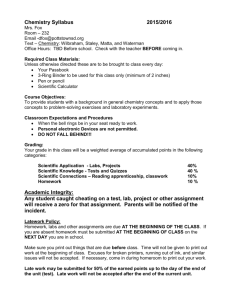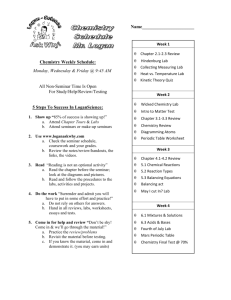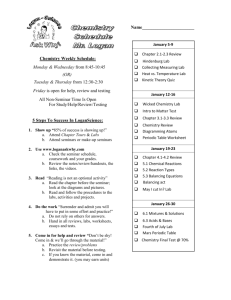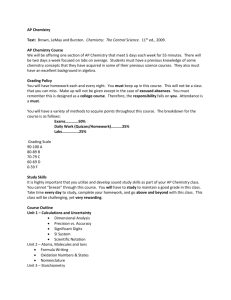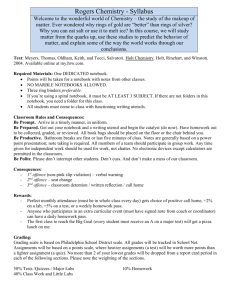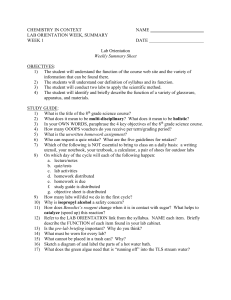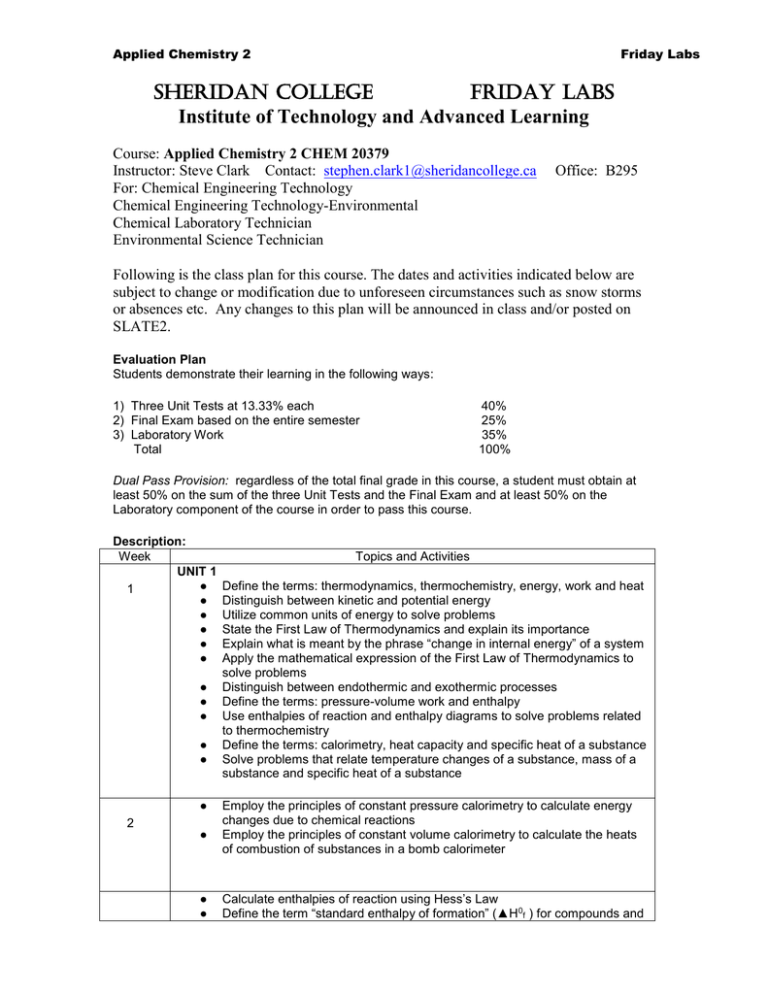
Applied Chemistry 2
Friday Labs
Sheridan College
FRIDAY LABS
Institute of Technology and Advanced Learning
Course: Applied Chemistry 2 CHEM 20379
Instructor: Steve Clark Contact: stephen.clark1@sheridancollege.ca
For: Chemical Engineering Technology
Chemical Engineering Technology-Environmental
Chemical Laboratory Technician
Environmental Science Technician
Office: B295
Following is the class plan for this course. The dates and activities indicated below are
subject to change or modification due to unforeseen circumstances such as snow storms
or absences etc. Any changes to this plan will be announced in class and/or posted on
SLATE2.
Evaluation Plan
Students demonstrate their learning in the following ways:
1) Three Unit Tests at 13.33% each
2) Final Exam based on the entire semester
3) Laboratory Work
Total
40%
25%
35%
100%
Dual Pass Provision: regardless of the total final grade in this course, a student must obtain at
least 50% on the sum of the three Unit Tests and the Final Exam and at least 50% on the
Laboratory component of the course in order to pass this course.
Description:
Week
UNIT 1
●
1
●
●
●
●
●
●
●
●
●
●
●
2
Topics and Activities
Define the terms: thermodynamics, thermochemistry, energy, work and heat
Distinguish between kinetic and potential energy
Utilize common units of energy to solve problems
State the First Law of Thermodynamics and explain its importance
Explain what is meant by the phrase “change in internal energy” of a system
Apply the mathematical expression of the First Law of Thermodynamics to
solve problems
Distinguish between endothermic and exothermic processes
Define the terms: pressure-volume work and enthalpy
Use enthalpies of reaction and enthalpy diagrams to solve problems related
to thermochemistry
Define the terms: calorimetry, heat capacity and specific heat of a substance
Solve problems that relate temperature changes of a substance, mass of a
substance and specific heat of a substance
●
Employ the principles of constant pressure calorimetry to calculate energy
changes due to chemical reactions
Employ the principles of constant volume calorimetry to calculate the heats
of combustion of substances in a bomb calorimeter
●
●
Calculate enthalpies of reaction using Hess’s Law
Define the term “standard enthalpy of formation” (▲H0f ) for compounds and
Applied Chemistry 2
3
4
5
6
7
8
9
Friday Labs
use standard enthalpy of formation data to calculate the enthalpy of
chemical reactions
● Compare the “fuel value” of various foods and various fossil fuels
● Define the term renewable energy and describe at least two forms of
renewable energy of interest today.
● Define the terms: oxidation reaction, reduction reaction, oxidation state,
oxidizing agent, reducing agent, half reaction
● Balance oxidation-reduction (redox) reactions
● Combine reaction stoichiometry and the principles of oxidation-reduction
reactions to solve problems
● IF TIME ALLOWS – HEAT TRANSFER
Unit 1 Test
UNIT 2
● State the characteristics of a chemical reaction that is in a state of “chemical
equilibrium”
● Describe how a chemical reaction can approach a condition of equilibrium
● Define the Law of Mass Action and explain how an equilibrium constant can
be determined
● Write equilibrium constant expressions for different types of chemical
reactions (Kc expressions)
● Write equilibrium constant expressions in terms of pressure, (Kp
expressions)
● Convert between Kc and Kp values
● Interpret the significance of the magnitude of a Kc value
● Determine the Kc value for the reverse reaction at equilibrium
● Manipulate the equilibrium constant to solve for desired reactions
● Write Kc and Kp expressions for heterogeneous reactions
● Calculate Kc or Kp values when equilibrium concentrations are known
● Calculate Kc or Kp values when initial and equilibrium concentrations are
known
● Calculate equilibrium concentrations when initial concentrations are known
● Explain Le Chatelier’s Principle
● Use Le Chatelier’s Principle to determine how chemical equilibrium is
affected by a change in pressure, volume or temperature in a system
● Describe how common catalysts work and if they impact equilibrium
Unit 2 Test
UNIT 3
● Define an acid and a base and state common properties for each
● Identify conjugate acid/base pairs in a chemical reaction
● Distinguish between strong acids and weak acids and strong bases and
weak bases
● Describe the process of autoionization of water and explain the origin of the
equilibrium constant expression for water, Kw.
● Describe the pH scale and calculate pH and pOH given the hydrogen ion
concentration in a solution
● Explain methods for measuring pH of solutions
● Calculate the pH and pOH of strong acids and strong bases
● Explain what is meant by an acid-dissociation constant, Ka for a weak acid
● Calculate Ka and percent ionization given pH and initial concentration of a
solution.
● Calculate pH given Ka values and initial concentration for a weak acid
solution
● Calculate the pH of a polyprotic acid given initial concentration and Ka
values
● Explain what is meant by a base dissociation constant, Kb
● Use Kb values and initial concentrations to calculate pOH for basic solutions
● Calculate the pH or pOH of different types of salt solutions
● Use the relationship: Kw = Ka x Kb to solve problems for conjugate acid
Applied Chemistry 2
base pairs (salt solutions)
Explain what is meant by the common ion effect and calculate the pH when
a common ion is involved in a mixture of two chemicals in water
● Explain how a buffer solution resists changes in pH when small amounts of
an acid or base are added to it
● Calculate the pH of a buffer solution
● Calculate the pH of a buffer when acid/base is added
● Provide common applications of buffers in everyday life
● Calculate the pH at the equivalence point of a strong acid/strong base
neutralization and draw the titration curve for this reaction
● Calculate the pH at the equivalence point of a strong acid/weak base
neutralization and draw the titration curve for this reaction
● Calculate the pH at the equivalence point of a weak acid/strong base
neutralization and draw the titration curve for this reaction
Unit 3 Test
UNIT 4
● Define the term “reaction kinetics”
● Describe how temperature, reactant concentration, physical state of
reactants and catalysts influence the rates of chemical reactions
● What are common units of reaction rate
● Explain how an average reaction rate can be determined for a given reaction
● Calculate the instantaneous reaction rate for a give chemical reaction
● Compare the relative rate of disappearance of reactants and the relative rate
of appearance of products based on the balanced chemical equation
● For a given chemical reaction, write an equation that allows one to calculate
the rate of reaction based on the concentration of reactants
● Define the terms: rate constant and reaction order and overall reaction order
● Describe an experiment that would allow you to determine a rate law based
on initial rate data for a given chemical reaction
● Use the equation for a first order reaction to solve problems
● Use the equation for a second order reaction to solve problems
● Use the half life equation to solve problems
● Define the terms: collision model, orientation factor, activation energy
● Explain how homogeneous and heterogeneous catalysts work
● Explain how enzymes function as catalysts in the body
● Write solubility product expressions (Ksp) for solubility equilibrium situations
● Calculate Ksp values given equilibrium concentrations of ions in solution
● Calculate solubility of compounds given their Ksp values
● Calculate the effect of a common ion on the solubility of a compound in
water
●
10
11
12
13
14
Friday Labs
Final Exam - Schedule to be posted on SLATE2
Applied Chemistry 2
Friday Labs
LABORATORY SCHEDULE APPLIED CHEMISTRY 2 – FRIDAY LABS WINTER 2014
Date
Experiment
Quizzes are worth a total of
5%
Who Writes
The Lab
Report?
Each Lab is worth 7.5%
Week 1
Week of
Jan 12 – 16
Week 2
Jan 19 – 23
Week 3
Jan 26 – 30
Week 4
Feb 2 – 6
Week 5
Feb 9 – 13
Week 6
Feb 16 – 20
Week 7
Feb 23 – 27
Week 8
Mar 9 – 13
Week 9
Mar 16 – 20
Week 10
Mar 23 – 27
Week 11
Mar 30 – Apr 3
No Lab Friday
Week 12
Apr 6 – 10
Week 13
Apr 13 – 17
SAFETY QUIZ
Laboratory Introduction/Safety
-Assign Locker Keys
-Partner A/B Sign Up
-Lab Report Expectations
-Plagiarism/Referencing
-Lab Manual Posted On SLATE2
Due Date (week of):
Reports are submitted at
the beginning of lab with
cover sheet/raw data.
If labs are late – 10% is
deducted per day for up
to 5 days then a mark of
zero is given.
No lab
write-up this
week
Paper Chromatography
Partner A
Week of Jan 26
Calorimetry
Partner B
Week of Feb 2
Heat of Reaction
Partner A
Week of Feb 16
Partner B
Week of Feb 23
Partner A
Week of Mar 16
Unit 1 Test – written in lab
Determination Of The
Amount Of Copper In
Bronze
Determination Of Vitamin C
Reading Week March 2 - 6
Unit 2 Test – written in lab
Dissociation Of A Weak Acid
Partner B
Week of Mar 23
Determination Of A
Solubility Product Constant
Unit 3 Test –To be written on
Partner A
Week of Apr 6
Partner B
Week of Apr 13
the afternoon of Thurs Apr 2 –
date and time to be
announced.
Reaction Kinetics
Locker Check Out
-Students must return keys
and sign out
Week 14: Exam Week – April 20 – 24
Both
Partners A
and B must
be present
Exam Date/Time and Room To Be Announced
Applied Chemistry 2
Friday Labs
Academic Procedures
The following practices apply to this course:
1. For tests and laboratory reports, the professor will specify dates and special instructions
at the beginning of the semester. Students are expected to plan ahead to ensure they are
available for all tests, exams and labs.
2. Students must complete every test and laboratory report as an individual effort unless the
professor specifies otherwise.
Students must write all tests at the scheduled time indicated in the class plan. Instructors
will specify the dates the tests will be written. The only acceptable excuse for a missed
test or exam or lab is a medical or legal certificate indicating the student’s inability to
attend. Where appropriate a make-up test will be arranged. The make-up test will be
written in the Assessment Center, a $10.00 charged will be required to write the test.
3. If a student is absent for any lab/test, or other event in which evaluation occurs, with
reason they must contact their professor, with supporting documentation, within five
school days for consideration. If a student fails to contact their professor within 5 school
days, a mark of zero will be given for the missed evaluation regardless of any reason or
documentation subsequently produced.
4. When a lab report is late, the mark awarded will be reduced due to a penalty for
lateness. For each day that the lab report is submitted late after the due date, 10% will be
deducted from the report up to a maximum of five days. Lab reports submitted more than
five days late will receive a grade of zero. The exception to this late penalty is a
medical/legal note as described above.
Late lab reports must either be submitted directly in person to your professor, or the
complete report must be emailed to your professor's Sheridan email account. If a late lab
report is submitted electronically, the time stamp on the email will be considered to be the
time of submission. If a late lab report is submitted via email, a hard copy of the lab
report, including raw data, must be submitted directly to your professor or to your
professor's mailbox, by the end of the following business day (from time of email
submission).
5. During any test or examination, the possession of electronic devices capable of
communicating with other devices, located either inside or outside the test or examination
room, is expressly forbidden. The only exceptions to this rule are devices used by
students with accommodations for special needs identified by the Accessible Learning
Services. This means that no student is allowed to bring to their desk during any test or
examination any laptop computer, netbook, cell phone, smartphone, pda or similar
device. If a student is found with such a device during a test or examination, depending
on the circumstances, one of two courses of action will be followed: a) The device will be
removed by the invigilator and collected by the student when they submit the paper and
leave the room or b) The possession of the device may be considered to represent an
academic offence and the matter will be dealt with under the terms of the College’s
Academic Honesty Policy.
6. During any test or examination, the possession of any device that plays recorded material
in any format, either audio or visual or both, such as an ipod, mp3 player, etc. is
forbidden. The only exceptions to this rule are devices used by students with
accommodations for special needs identified by the Accessible Learning Services. If a
student is found with such a device during a test or examination depending on the
circumstances one of two courses of action will be followed: a) The device will be
Applied Chemistry 2
Friday Labs
removed by the invigilator and collected by the student when they submit the paper and
leave the room or b) The possession of the device may be considered to represent an
academic offence and the matter will be dealt with under the terms of the College’s
Academic Honesty Policy.
7. The professors reserve the right to specify the types of hand held calculators used during
any test or examination. Such specification shall be given in class sufficiently in advance
of the test or examination to enable all students to comply. The professor may announce
that for a particular test calculators with some specified capability, such as graphing, for
example, are not permitted.
The only exceptions to this rule are devices used by
students with accommodations for special needs identified by the Accessible Learning
Services. If a student is unsure if their calculator will be permitted, it is their responsibility
to check in advance with the professor. If a student is found with a calculator with
forbidden capabilities during a test or examination depending on the circumstances one
of two courses of action will be followed: a) The device will be removed by the invigilator
and collected by the student when they submit the paper and leave the room or b) The
possession of the device may be considered to represent an academic offence and the
matter will be dealt with under the terms of the College’s Academic Honesty Policy.
8. It is expected that all students understand and follow Sheridan’s Academic Integrity
Policy concerning plagiarism, cheating, etc. policies and expectations. (The policy can be
found at https://policy.sheridanc.on.ca/dotNet/documents/?docid=673&mode=view)
If you are involved in an academic integrity offence, the Sheridan College Academic
Integrity Procedure will be applied. Typically, the first offence (breach of academic
integrity) results in a grade of zero for the lab report, assignment, quiz, test or final exam
on which the breach occurred, with no opportunity to resubmit the work. The second
offence will result in an F grade in the course in which the second breach occurred. The
third offence will result in a TM (termination) grade in the course in which the third breach
occurred. Fourth, fifth and sixth offences will result in administrative withdrawal,
suspension and expulsion, respectively, from the college.
9. During tests, there will be no sharing of materials, this includes but is not limited to
calculators, pens, pencils, erasers, rulers etc. Students must bring their own pencil, pen,
eraser and calculator to each test.
10. During tests, no talking is allowed. Talking during a test is an academic offense and will
result in a grade of zero.
11. If a student misses a lecture class, it is his/her responsibility to catch up and to get any
missed notes etc from classmates.
12. Due to health and safety requirements in our Chemical laboratories, the professor may
establish a time limit (e.g. 5 minutes) for students to arrive, equipped and prepared for
laboratory work. Students arriving after this time limit will not be allowed to perform the
laboratory and will be deemed to have been absent. Consequences for missing a lab –
see note 3 above.
Applied Chemistry 2
Friday Labs
For all laboratory work, the following procedures and expectations apply:
Pre-lab quizzes may be given randomly throughout the semester. The pre-lab quizzes will
start on the hour. For example if the lab begins at 10:00am, your pre-lab quiz will start at
10:00am. Pre-lab quizzes will contain material from the lab being conducted that day
however, it also may contain calculations/theory from previous labs conducted. After the quiz
there will be a pre-lab safety talk.
It is important for all students to attend and listen to the pre-lab safety talk. If a student arrives
later than 5 minutes after the lab has started and the pre-lab safety talked has been missed,
he or she will be asked to leave the lab and a grade of zero will be given for the missed lab.
A schedule of laboratory experiments and activities is included in this class plan. Attendance
of all labs is mandatory.
1. Laboratory experiments will be posted on SLATE2. It is the student’s responsibility to
print, read and prepare for the laboratory exercise. All students will be given a laboratory
notebook. All experimental data/observations will be recorded in the laboratory
notebook.
2. Safety regulations and procedures are given in the Student Safety Manual posted on
SLATE2. It is the responsibility of the students to read and understand the contents in
the manual before conducting any experiments. Rules in the safety manual must be
followed during ALL labs.
3. A safety test will be given in the first week of lab. Students must prepare for the test by
studying the safety manual. To conduct any experiment it is required to pass the safety
test. The passing mark for this test is 80%.
4. Students are expected to follow all laboratory safety rules specified by the professor and
as indicated in the laboratory and safety manuals. Failure to wear safety glasses, a lab
coat and full toe shoes as well as other unsafe practices may result in a grade of zero for
the lab or students may be asked to leave the lab.
5. Students will work in pairs on laboratory experiments. Laboratory groups will be formed
in the first week of classes. A schedule will be established, distributed and posted
detailing the labs to be completed each week and the due dates for each report. This
schedule must be strictly adhered to. All lab reports must be typed and graphed on excel
(if required).
6. If a student is absent for a lab that they are not responsible for writing, 50% will be
deducted from their lowest report mark. If a second lab is missed that a student is not
responsible for writing, 50% will be deducted from the second lowest report mark etc.
7. There are no opportunities for “making up” missed laboratories.
8. If a student misses a locker check-in/check-out or review lab period 50% will be deducted
from their lowest report mark.
9. If you are unsure about whether a report or assignment is to be done individually or
collaboratively, it is your responsibility to clarify this with the professor.
Applied Chemistry 2
Friday Labs
For all lecture sections the following expectations apply:
1. It is important that all students attend their designated lecture section.
2. If a student has an IEP (Individual Education Plan) profile or a disability, it is the student’s
responsibility to register with the Accessible Learning Center and inform their instructor
(both lab and lecture) of their accommodations.
3. If a student arrives late to their lecture, they are expected to enter the class quietly and
find a seat quietly. Do not disrupt the lecture, respect the learning of others.
4. There will be no irrelevant talking during lecture. A warning will be given to students who
do not follow this expectation, after which the student will be asked to leave the lecture.
5. Computers are not necessary in this course therefore they will not be used during lecture.
6. It is expected that students turn off their cell phones and do not answer phone calls
during lecture. As well, students should not be texting during lecture.
7. Before coming to lecture, print the required PowerPoint presentation from SLATE2.
8. The use of a recording device (including a voice recorder, camcorder, camera or cell
phone) is prohibited in the classroom without the instructor’s consent. No pictures can be
taken during lecture.
The textbooks used in this course is the same as Applied Chemistry 1:
Chemistry, The Central Science, 12th Edition, by Brown, LeMay, Bursten, Murphy, and
Woodward (2011), Pearson, Prentice Hall.
Chemistry, The Central Science, 13th Edition, by Brown, LeMay, Bursten, Murphy, Woodward
and Stoltzfus (2014), Pearson, Prentice Hall.

